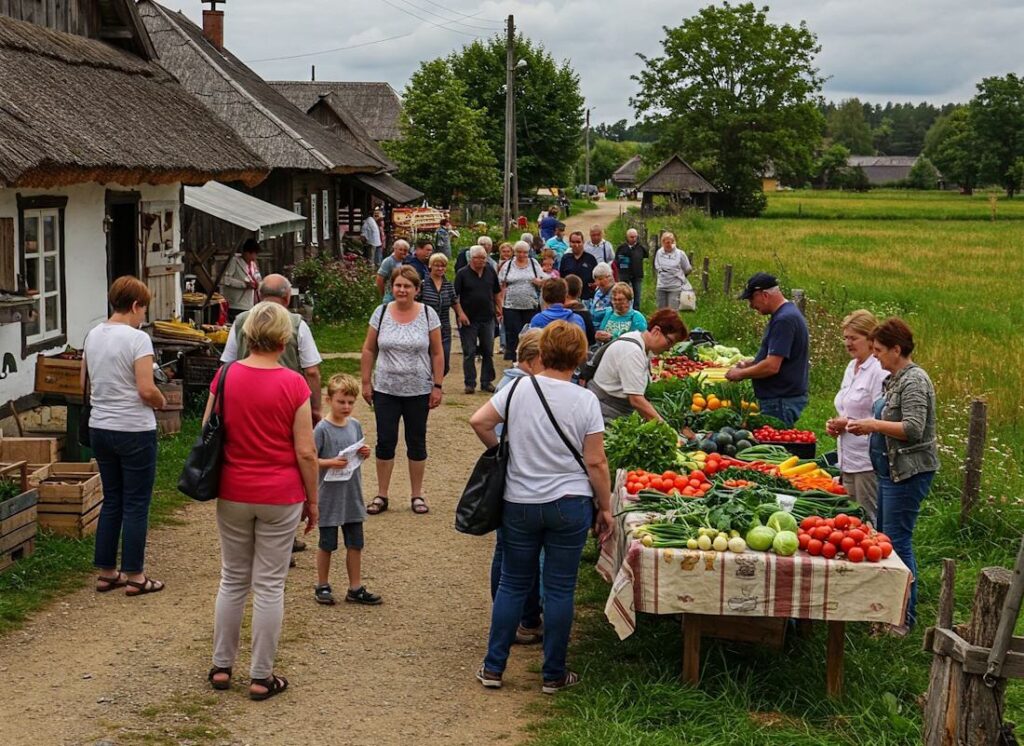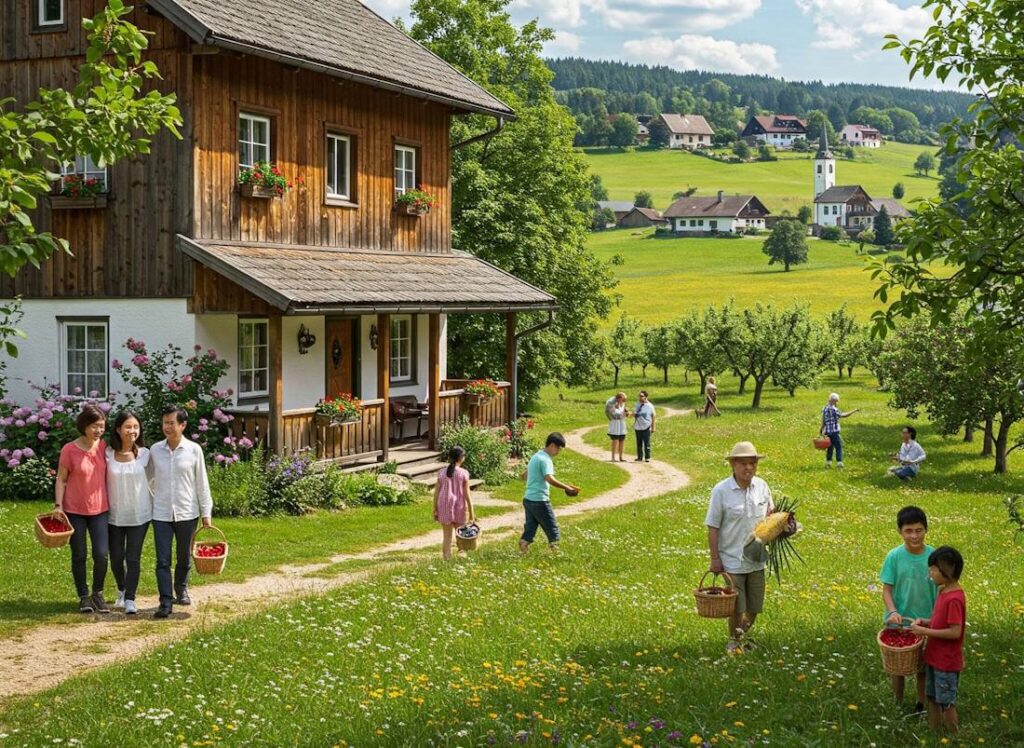Rural tourism refers to the practice of visiting rural areas, where visitors engage with the natural environment, local culture, and traditional lifestyles. This form of tourism encompasses a variety of experiences, including agritourism, eco-tourism, and cultural events, offering a stark contrast to the fast-paced atmosphere of urban tourism. While urban areas often attract tourists with their vibrant nightlife, shopping districts, and historical monuments, rural destinations provide a more tranquil setting that emphasizes nature, heritage, and community engagement.
The significance of rural tourism in local community development cannot be overstated. This form of tourism has the potential to bolster economic growth by supporting local businesses, creating jobs, and enhancing the overall quality of life in rural locales. As tourists flock to these regions seeking unique experiences, a diverse range of enterprises—such as bed-and-breakfast establishments, craft shops, and local farms—can thrive, resulting in a more resilient local economy.
Moreover, rural tourism fosters greater appreciation for biodiversity and traditional practices among visitors. Many rural areas are adorned with breathtaking landscapes, from rolling hills to pristine lakes, offering activities such as hiking, farming, and wildlife watching. Additionally, these regions often boast rich cultural heritage, including traditional festivals, artisanal crafts, and indigenous culinary practices, which attract tourists eager to experience authentic local life. Such engagements also facilitate cultural exchange and learning opportunities that can benefit both the visitors and the residents.
In conclusion, rural tourism serves as a vital catalyst for sustainable development in countryside regions, providing communities with the tools necessary to flourish economically while preserving their unique identities and environments. As this sector continues to evolve, understanding its various facets becomes crucial for stakeholders looking to harness its full potential.
Economic Benefits for Local Businesses
Rural tourism has emerged as a significant contributor to the economic vitality of local communities. The direct economic advantages experienced by rural businesses are manifold, primarily stemming from the influx of tourists seeking authentic experiences away from urban centers. An increase in visitor numbers typically translates to heightened sales for small businesses, such as restaurants, shops, and accommodation providers. These establishments often rely heavily on seasonal tourism, where peaks in visitors can lead to substantial revenue increases, particularly in regions where such traffic is otherwise limited.
Moreover, rural tourism creates new job opportunities within these localities. As tourists flock to rural destinations, the demand for services rises, creating a ripple effect that necessitates hiring additional staff. This need not only bolsters employment rates in rural areas but can also attract a younger workforce, skilled in hospitality and local craft production. Such trends are evidenced in several rural communities where tourism has revitalized job markets and provided vital economic support, fostering greater financial stability for families and individuals.
Additionally, rural tourism stimulates adjacent local industries, including agriculture and craft production. Farmers and artisans are presented with new market opportunities to showcase their products, ranging from organic produce to handmade goods. Visitors often seek locally sourced items, which encourages producers to innovate and promote their unique offerings. A case in point is the successful integration of agritourism in rural areas, where farm stays and farmer’s markets draw visitors eager to connect with local cultures and economies. These ventures fortify the local economy, enhancing livelihoods and supporting the sustainability of community businesses.
Job Creation and Employment Opportunities
Rural tourism serves as a crucial driver of job creation within communities, revitalizing local economies by offering an array of employment opportunities. The diverse nature of rural tourism generates positions across several sectors, from hospitality to retail, each tailored to meet the needs stemming from increased visitor interest. Hotels, bed-and-breakfasts, and local restaurants require staff to accommodate and serve tourists, while attractions such as parks and historical sites often employ tour guides to enhance visitor experiences. This multifaceted employment landscape not only creates jobs but also fosters a sense of community by promoting local culture and heritage.
Additionally, rural tourism encourages the growth of agricultural and related sectors. Farmers and artisans can find new revenue streams as they sell products directly to tourists or integrate them into tourism experiences, such as farm stays or craft workshops. These opportunities often lead to job creation in food production, sales, and marketing, further strengthening the community’s economic fabric.
Moreover, the rise in tourism brings about a pressing need for trained professionals in various fields. In response, many rural areas initiate training programs and skill development initiatives to equip the local workforce with essential capabilities. Community colleges and organizations frequently collaborate to offer courses in hospitality management, customer service, and eco-tourism practices, ensuring that residents can compete effectively for available positions. As a result, the demand for skilled workers attracts investment in education, preparing individuals for long-term career paths.
In summary, rural tourism significantly impacts local job creation by generating diverse job opportunities across multiple sectors, reducing unemployment rates while also promoting skill development initiatives. The commitment of communities to cultivating a workforce ready to meet tourism demands leads to sustainable employment and economic development. As rural tourism continues to flourish, its contributions to job creation will be pivotal for the resilience of local communities.
Cultural Preservation and Community Empowerment
Rural tourism offers a unique platform for the preservation of cultural heritage and local traditions, serving as a catalyst for community pride and involvement. By attracting visitors to rural areas, tourism encourages local communities to showcase their distinct customs, crafts, and cultural practices. These interactions not only introduce tourists to the richness of rural life but also instill a sense of pride within local residents. The recognition and appreciation of their heritage motivate communities to actively maintain and promote their cultural assets, ensuring that traditional practices remain vibrant and relevant.
Moreover, rural tourism creates opportunities for local artisans and craftspeople to present their work, providing a direct economic incentive to preserve traditional techniques. Visitors often seek authentic experiences, and by showcasing their crafts, local communities can generate income while keeping their heritage alive. This dynamic phenomenon not only benefits individual entrepreneurs but also strengthens the community’s cultural identity, contributing to collective well-being and resilience.
Empowerment occurs as rural tourism enables local residents to take charge of their resources and decisions regarding tourism development. When communities engage in tourism planning and management, they ensure that the activities reflect their values and aspirations. This participatory approach allows residents to voice their needs and concerns, fostering a sense of ownership over the tourism experience. As a result, they can influence the direction of tourism initiatives, ensuring that they align with community priorities and contribute positively to the local economy.
In essence, rural tourism serves as a powerful tool for both cultural preservation and community empowerment. By facilitating the maintenance of local traditions and providing residents with opportunities for meaningful participation, rural tourism enriches not only the visitor experience but also the lives of those in the host communities. This symbiotic relationship ultimately enhances the sustainability and resilience of rural areas, making them vibrant places to live and visit.
Environmental Conservation and Sustainability
Rural tourism plays a pivotal role in promoting environmental sustainability and conservation efforts, further establishing a symbiotic relationship between nature, community, and tourism. Through initiatives that emphasize responsible tourism practices, such as eco-tourism, rural areas are able to strike a balance between attracting visitors and preserving their natural heritage. This approach benefits not only the environment but also enriches the local community’s well-being.
Eco-tourism, as a subset of rural tourism, focuses on improving environmental protection while generating economic opportunities for local populations. By engaging in eco-friendly activities such as guided nature walks, wildlife spotting, and organic farming tours, tourists are educated about the importance of conservation, promoting an ethos of environmental stewardship. This type of tourism fosters an appreciation for natural resources, and when tourists engage in activities that respect the surrounding ecosystems, it supports wildlife preservation and can even aid in the rehabilitation of damaged habitats.
Moreover, sustainable agriculture practices employed within rural tourism initiatives create a connection between visitors and local produce. By sourcing food from local farms, tourist establishments encourage the use of organic farming techniques, which not only reduce carbon footprints but also promote biodiversity. These sustainable practices ensure the longevity of local resources while providing tourists with fresh, authentic culinary experiences that reflect the cultural heritage of the area.
Furthermore, when communities embrace such initiatives, they often experience a greater sense of ownership and pride in their natural surroundings. This sense of responsibility towards the environment, coupled with the benefits of rural tourism, fosters stronger community bonds and enhances the overall quality of life for residents. As rural tourism continues to evolve, its commitment to environmental conservation and sustainability will remain critical in addressing the challenges faced by both local communities and the broader ecosystem.
Community Infrastructure Development
Rural tourism plays a significant role in the enhancement of community infrastructure, which is crucial for accommodating tourists and bolstering local economies. As rural destinations become increasingly popular, investments in transportation networks, including roads and public transit, are often prioritized. Improved access not only facilitates travel for visitors but also contributes positively to the everyday lives of residents. Better roads reduce travel times, enhance safety, and can lead to an influx of goods and services that were previously challenging to obtain.
Moreover, the rise of rural tourism often catalyzes advancements in communication infrastructure. The demand for reliable internet access and mobile connectivity grows as more travelers seek information and services online. In response, local governments and businesses frequently invest in broadband expansion, ensuring that both tourists and residents benefit from enhanced technological access. This connectivity is essential not only for daily activities but also serves as a vital tool for local businesses aiming to reach broader markets.
Public services, such as waste management and public health, also undergo improvements as a result of increased tourism. Local governments recognize that a higher population — even if temporary — necessitates better sanitation, waste disposal, and healthcare services. Investments in these areas ensure that both visitors and the local community can enjoy a clean and healthy environment. Furthermore, these enhancements often create jobs, providing employment opportunities for residents and fostering economic growth.
As rural areas develop infrastructure to support tourism, they inadvertently enhance the quality of life for local inhabitants. These improvements make rural places more attractive for potential long-term residents, thereby contributing to population stability and growth. The interconnectedness of tourism and community infrastructure truly illustrates how visitors can inadvertently pave the way for a better living experience for local populations, creating a sustainable cycle of development.
Challenges and Considerations in Rural Tourism
Rural tourism, while offering numerous benefits to local communities and economies, also presents various challenges that merit careful consideration. One significant issue is the risk of over-tourism, where an influx of visitors can exceed the capacity of the local infrastructure. This phenomenon can strain resources, including housing, water supply, and waste management systems, leading to decreased quality of life for residents. In many rural areas, which often lack the infrastructure found in more urban settings, rapid growth in tourism can overwhelm local services, creating tensions between visitors and the resident population.
Another concern is the potential loss of cultural authenticity. As rural destinations become more popular, there can be a tendency to commercialize local traditions and practices in response to tourism demands. This can result in an experience that feels staged or inauthentic, diverging from the true essence of the community’s culture. Such developments often prioritize the preferences of tourists over those of local residents, leading to a dilution of cultural heritage. It is essential for communities to strike a balance that allows for cultural sharing while safeguarding their unique identities.
Moreover, the economic dependence that can arise from reliance on tourism can pose risks to local communities. If economic activities become overly concentrated on this sector, communities may find themselves vulnerable to fluctuating tourist numbers and external market forces. This dependency can limit diversification and make local economies susceptible to downturns during off-peak seasons or global crises, such as pandemics. In response to these challenges, it is crucial for rural tourism stakeholders to engage in thoughtful planning and implement sustainable practices to mitigate negative impacts, ensuring that tourism development is equitable, responsible, and beneficial for local communities.
Case Studies of Successful Rural Tourism Initiatives
Rural tourism initiatives across the globe have demonstrated considerable potential in fostering community development and enhancing local businesses. One noteworthy case study is found in the rural town of Svaneti, Georgia. With its breathtaking mountain landscapes and rich cultural heritage, Svaneti has embraced eco-tourism and cultural experiences as its primary tourism strategies. The local community has worked collaboratively to create guesthouses, introduce traditional culinary workshops, and offer guided nature hikes, thereby enhancing local employment opportunities while promoting cultural preservation.
Another illustrative example is the village of Håbo, Sweden, which has successfully transformed its agricultural space into a multi-faceted rural tourism destination. Through the establishment of farm-to-table dining experiences and agricultural workshops, local farmers have diversified their income, engaging urban visitors interested in sustainable farming practices. This initiative has not only educated tourists about rural life but has also nurtured a renewed appreciation for local produce, strengthening community ties and creating a vibrant marketplace for local products.
In the United States, there is the case of the Finger Lakes region in New York, which capitalized on its natural beauty and wine production. Through strategic marketing campaigns that highlighted outdoor activities such as hiking and wine tasting, the area experienced significant growth in tourism. Local businesses have flourished, with wineries and farms working collaboratively to create tourism packages. Additionally, educational initiatives aimed at informing tourists about sustainable practices in agriculture have further solidified the community’s commitment to responsible tourism.
Finally, looking towards the Southern Hemisphere, the rural community of Martinborough, New Zealand, leveraged its picturesque vineyards and local festivals to draw visitors. By hosting events such as the Martinborough Wine & Food Festival, the town has successfully attracted tourists while promoting local artisans and businesses. These case studies collectively illustrate how strategic planning, community involvement, and a focus on sustainability can breathe new life into rural areas, ultimately leading to enhanced economic development and community pride.
Future Trends in Rural Tourism
As rural tourism continues to evolve, several emerging trends are becoming increasingly prominent, reshaping the landscape of local economies and communities. One such trend is the rise of agritourism, where visitors engage directly with agricultural practices. By offering farm stays, interactive experiences, and farm-to-table dining, rural destinations are capitalizing on the growing consumer interest in sustainable practices and locally sourced food. This not only provides supplementary income for farmers but also fosters a greater appreciation for agricultural lifestyles among tourists.
An additional trend gaining traction is the development of wellness retreats in rural areas. With an increasing number of individuals seeking retreats that promote mental and physical well-being, rural settings provide the perfect backdrop for relaxation and rejuvenation. The serene landscapes, combined with activities such as yoga, meditation, and hiking, entice visitors looking to escape the stress of urban life. As health and wellness become more prioritized in tourism, rural communities can benefit from this shift by diversifying their offerings and tailoring experiences to meet this demand.
Moreover, the phenomenon of digital nomadism is increasingly influencing rural tourism. As remote work becomes more accepted, many professionals are seeking out tranquil rural environments in which to work and play. This shift is leading local businesses to adapt, providing coworking spaces, high-speed internet, and accommodations catering to long-stay visitors. The integration of technology not only enhances the visitor experience but also stimulates local economies as businesses adjust to meet the needs of this new demographic.
Overall, the evolution of rural tourism is closely tied to the changing preferences of travelers. By adapting to these trends, rural communities can cultivate sustainable growth, providing economic benefits while simultaneously preserving their unique cultural and natural heritage. Technology will undoubtedly play a critical role in supporting these developments, ensuring that local businesses remain competitive in an increasingly digital world.



